| Article ID | Journal | Published Year | Pages | File Type |
|---|---|---|---|---|
| 522991 | Journal of Computational Physics | 2006 | 29 Pages |
An efficient and accurate parallel coupled DSMC–NS method using three-dimensional unstructured grid topology is proposed and verified for the simulation of high-speed gas flows involving continuum and rarefied regimes. A domain overlapping strategy, taking advantage of unstructured data format, with Dirichlet–Dirichlet type boundary conditions based on two breakdown parameters is used iteratively to determine the choice of solvers in the spatial domain. The selected breakdown parameters for this study include: (1) a local maximum Knudsen number defined as the ratio of the local mean free path and local characteristic length based on property gradient and (2) a thermal non-equilibrium indicator defined as the ratio of the difference between translational and rotational temperatures to the translational temperature. A supersonic flow (M∞ = 4) over a quasi-2-D 25° wedge is employed as the first step in verifying the present coupled method. The results of simulation using the coupled method are in excellent agreement with those of the pure DSMC method, which is taken as the benchmark solution. Effects of the size of overlapping regions and the choice of breakdown parameters on the convergence history are discussed. Results show that the proposed iteratively coupled method predicts the results more accurately as compared to the “one-shot” coupled method, which has been often used in practice. Further, a realistic 3-D nitrogen flow, which two near-continuum parallel orifice jets underexpand into a near-vacuum environment, is simulated using the present coupled method to demonstrate its capability. Finally, developments in extending the present method are also outlined in this paper.
